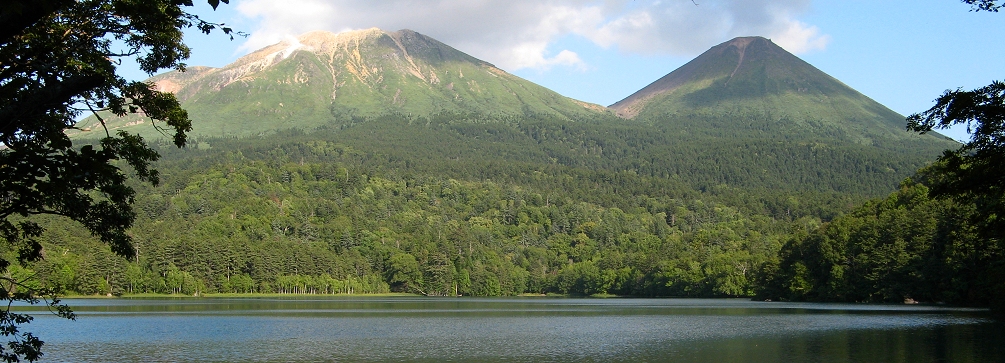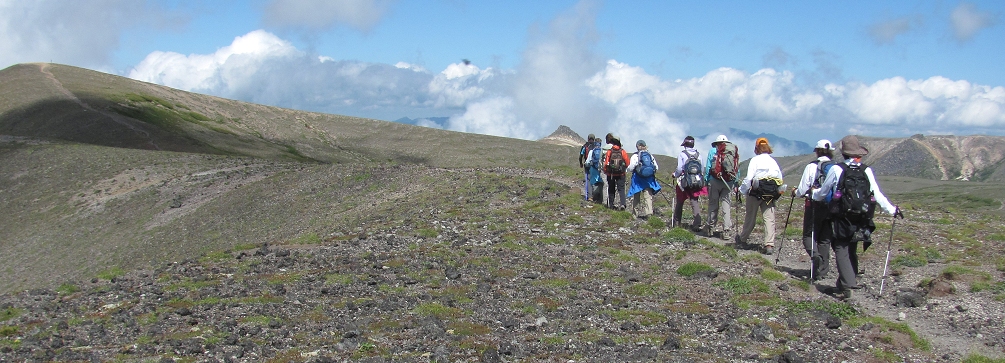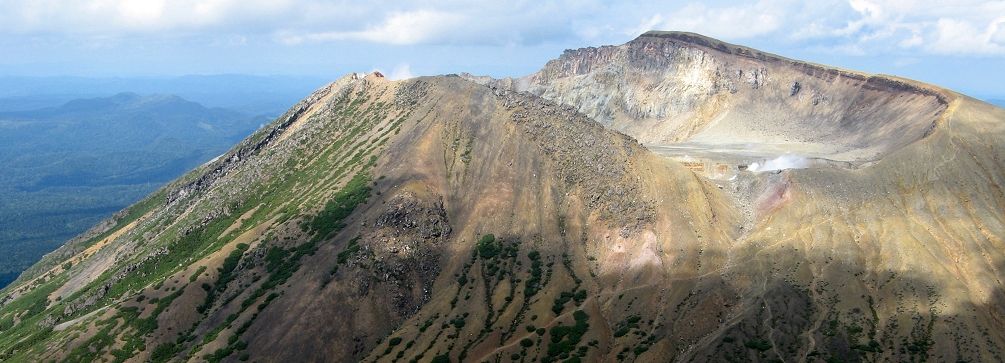Hiking on Hokkaido
Japan’s Far North

Printable version of trip itinerary
Traveling in Japan in 2025: What to Expect

Discover the mountain trails of Japan’s northern island of Hokkaido. Among the Japanese islands, Hokkaido may be lacking in the cultural monuments so often associated with Japan, but it offers an abundance of wide-open spaces, wilderness landscapes, and the best opportunities for outdoor activities in the country. (Hokkaido accounts for one-fifth of the total Japanese landmass, but only 5% of Japan’s population lives there!) On this trip we’ll sample the mountain trails of four national parks—Shikotsu-Toya, Daisetsuzan, Akan, and Shiretoko.
In our opinion, Hokkaido offers some of the best mountain hiking in Japan. The mountain landscapes of Hokkaido are volcanic in character — steaming cones and hot springs, colorful cinder fields and quiet forest ringed crater lakes. You’ll have an opportunity to hike the Daisetuzan Traverse which is in our opinion one of the best day-long high country hikes anywhere!

Autumn comes to the Daisetsuzan high country, Hokkaido, Japan.

Arrival day
Overnight in Chitose
Arrival at Sapporo (New Chitose Airport, CTS). Overnight at accommodations in Chitose town which is less than ten minutes by train from the airport. Dinner on your own.

The lava dome of the Tarumae volcano, Shikotsu-Toya National Park.
Day 1
Overnight in Chitose
Breakfast, lunch and dinner included
Travel from Chitose to the shores of the Shikotsu crater lake (Shikostu-ko) in the heart of the Shikotsu-Toya National Park (支笏洞爺国立公園). Hike up the volcanic cinder slopes of the Tarumae-san volcano. From the crater rim, enjoy a stunning view of the volcano’s lava dome. Far below you, the waters of the Pacific Ocean shimmer. Ascend to the summit of the west peak of Tarumae-san before returning to the trailhead. Travel by vehicle back to Chitose and overnight.


Asahidake volcano from Asahidake Onsen.
Day 2
Overnight in Asahidake Onsen
Breakfast, lunch and dinner included
This morning, travel by vehicle to Asahidake Onsen on the western slopes of Hokkaido’s magnificent Daisetsuzan massif. You’ll spend the evening at the small mountain settlement of Asahidake Onsen above which rises 7,500 foot tall Mount Asahidake, the highest peak on Hokkaido. Upon arrival, a short hike will introduce you to the lush woodlands that cloak the lower slopes of Asahidake volcano. Labels along the trail identify key tree species. The hike ends at a garden featuring the alpine plants (many endemic) that grow in the highlands of the Daisetsuzan National Park.

Japanese gentians (Gentiana nipponica)–a sampling of the wildflowers riches of the Daisetsuzan.


Daisetsuzan high country en route to Nakadake Onsen.
Day 3
Overnight in Sounkyo
Breakfast, lunch and dinner included
From Asahidake Onsen, ascend into the mountains by cable car (called a “ropeway” in Japan). From the cable car’s upper station near the Sugatami Ponds, begin a hike across the Daisetsuzan National Park (大雪山国立公園) whose name translates as “big snow mountain.” This full-day trek across wild, alpine landscapes offers expansive vistas across the “roof of Hokkaido.” From the Sugatami Ponds, follow the trail through fields of Aleutian avens (a wildflower known as chinguruma in Japanese) to the Nakadake Onsen (a natural volcanic hot spring). Soak your feet in the warm waters surrounded by the mountains of Daisetsuzan! The shorter hiking option turns back at this point. For a longer and more challenging hike, continue beyond Nakadake Onsen to gain the rim of the large Ohachidaira caldera. The trail continues to Kurodake (“Black Mountain”) from where it descends the northern flanks of the Daisetsuzan massif. Finish off the day with a chairlift and cable car ride down to Sounkyo Onsen, set in the bottom of a dramatic, waterfall-lined gorge.

Hiking across the high Daisetsuzan; The peak of Hakuundake in the background.

Autumn tints the high country of Daisetsuzan.


Midori-numa (Green Lake), Daisetsu-Kogen.
Day 4
Overnight in Sounkyo
Breakfast, lunch and dinner included
Enjoy a second day of hiking in the Daisetsuzan National Park. Travel by vehicle to an area on the eastern slope of the Daisetsuzan known as Daisetsu-Kogen (Daisetsu Plateau). Today’s hike leads to the Daisetsu Kogen Numa—a cluster of small subalpine lakes set into a mountain basin at the foot of the Takane-ga-hara escarpment. Here, fragrant woodlands, rushing streams, and bubbling hot springs complete a picture of scenic grandeur at the heart of Daisetsuzan National Park.

Daigaku-numa (University Lake).

Autumn color in Daisetsuzan National Park.


Waterfalls in the Sounkyo Gorge. Ginga-no-taki (left) and Ryusei-no-taki (right).
Day 5
Overnight in Akan National Park
Breakfast, lunch and dinner included
In the morning, enjoy a short hike to the So-baku-dai viewpoint from where you’ll view two spectacular waterfalls that grace the walls of the Sounkyo gorge. Later, travel to the Akan National Park (阿寒国立公園) enjoying a visit to the Museum of the Northern Peoples en route. Three lovely “crater lakes” are protected within the boundaries of Akan National Park. One of these crater lakes, Lake Akan (阿寒湖, Akan-ko), is known for the unusual balls of the marimo algae that grow in the lake. Upon arrival at Lake Akan, enjoy a short walk along the shoreline to the bubbling mudpots at the Bokke thermal area. Overnight in Akan-kohan on the shores of Akan-ko.

Oakandake volcano rises above Lake Akan.


The lake of Onneto as seen from timberline on Meakandake volcano.
Day 6
Overnight in Akan National Park
Breakfast, lunch and dinner included
From the picturesque lake of Onneto, hike up to the summit of Meakandake (an active volcano) and enjoy spectacular vistas over the large steaming and rumbling summit crater of the volcano. In the other direction, views extend over Meakandake’s subsidiary craters and beyond to the wooded expanses of Akan National Park. Descend the volcano’s eastern flank to a mountain saddle above which rises the wonderfully symmetrical cone of the Akan Fuji volcano. The trail continues its descent through stands of dwarf pine (Pinus pumilla) before entering a beautiful forest of Hokkaido red spruce (Picea glehnii) at trail’s end. Travel back to the shores of Lake Akan where you’ll spend a second night.

Akan Fuji as seen from the summit of Meakandake.


The crater lake of Mashu-ko in Akan National Park.
Day 7
Overnight in Utoro
Breakfast, lunch and dinner included
After breakfast, travel to the pristine caldera lake of Mashū-ko (摩周湖) which some consider the most beautiful lake in Japan. See if you agree! There’ll be time to enjoy the classic beauty of this lake as well as to stretch your legs on a hike along a bamboo-lined trail to a dramatic vantage point high above either Mashū-ko or above Lake Kussharo, another of Akan National Park’s caldera lakes. Continue to the Shiretoko Peninsula, one of the wildest areas in Japan, named a World Heritage Site by UNESCO in July 2005. We’ll spend the evening in the coastal town of Utoro overlooking the Sea of Okhotsk and a gateway to the Shiretoko National Park (知床国立公園).

Oshinkoshin waterfall near Utoro.


On a crystal clear day, the summit of Rausu-dake beckons.
Day 8
Overnight in Utoro
Breakfast, lunch and dinner included
This morning, travel by vehicle to the trailhead at Iwaobetsu Onsen. From here, weather permitting, hike a switchbacking trail to the summit of Mount Rausu (Rausu-dake), one of several old volcanoes that together formed the Shiretoko Peninsula. From the summit of Rausu-dake, enjoy a glorious vista northward down the untrammeled volcanic spine of Shiretoko. To the west shimmers the Sea of Okhotsk while to the east, the Kuril Islands (today a part of Russia) float on the waters of the Pacific. If the weather makes a high country hike inadvisable, we’ll substitute an alternate hike. Of, if you’d like to take a day off from hiking, consider a boat tour up the rugged western coast of the Shiretoko Peninsula where waterfalls plunge over cliffs into the sea. If you’re lucky, you might even spot Hokkaido brown bears foraging along the coast. (The cost of the boat tour is not included in the trip price.) Return to Utoro for the evening and enjoy a farewell dinner to celebrate the conclusion of your Hokkaido hiking adventure!

The view down the wilderness spine of the Shiretoko Peninsula from the slopes of Rausu-dake.

Twisted birches line the trail to Rausu-dake.


The peaks of the Shiretoko Peninsula as seen from the Shiretoko Five Lakes.
Day 9
Departure from Memanbetsu
Breakfast and lunch included
After breakfast, travel by vehicle from Utoro to the Shiretoko Goko (Shiretoko Five Lakes). Enjoy a short walk along trails and boardwalks that leads past the lakes which, if weather conditions are right, majestically reflect the line of peaks along the spine of the Shiretoko Peninsula. Then, continue to Memanbetsu Airport (MMB) for your departure. Please do not plan your departure from Memanbetsu for earlier than 4:30 PM on this day. Your lodging for this evening is not included in the trip price.

View of the Sea of Okhotsk from Utoro.

Autumn flora in Hokkaido.

Other Resources
![]() One traveler’s experience of traveling in Hokkaido is recounted in “The End of the Earth,” an article published in the November 2006 issue of Travel & Leisure Magazine.
One traveler’s experience of traveling in Hokkaido is recounted in “The End of the Earth,” an article published in the November 2006 issue of Travel & Leisure Magazine.
![]() The Asahidake Ropeway site contains information on the sights and features made accessible by the ropeways. The Asahidake Visitor Center site has a great little run-down on Daisetsuzan’s flora and fauna.
The Asahidake Ropeway site contains information on the sights and features made accessible by the ropeways. The Asahidake Visitor Center site has a great little run-down on Daisetsuzan’s flora and fauna.
![]() Browse through a comprehensive selection of Japanese topographic maps on-line. Happy browsing!
Browse through a comprehensive selection of Japanese topographic maps on-line. Happy browsing!
![]() Live webcam view of Utoro harbor on the Shiretoko Peninsula.
Live webcam view of Utoro harbor on the Shiretoko Peninsula.

Daisetsuzan trail.

Hiking across the “roof of Hokkaido” on the Daisetsuzan Traverse.

Printable version of trip itinerary
Traveling in Japan in 2025: What to Expect



Photos on this page are by John Osaki (© All Rights Reserved) except as otherwise credited.





